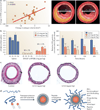Perspectives and opportunities for nanomedicine in the management of atherosclerosis
- PMID: 22015921
- PMCID: PMC3623275
- DOI: 10.1038/nrd3578
Perspectives and opportunities for nanomedicine in the management of atherosclerosis
Erratum in
- Nat Rev Drug Discov. 2011 Dec;10(12):963
Abstract
The use of nanotechnology for medical purposes--nanomedicine--has grown exponentially over the past few decades. This is exemplified by the US Food and Drug Administration's approval of several nanotherapies for various conditions, as well as the funding of nanomedical programmes worldwide. Although originally the domain of anticancer therapy, recent advances have illustrated the considerable potential of nanomedicine in the diagnosis and treatment of atherosclerosis. This Review elaborates on nanoparticle-targeting concepts in atherosclerotic disease, provides an overview of the use of nanomedicine in atherosclerosis, and discusses potential future applications and clinical benefits.
Figures






Similar articles
-
Emerging potential of stimulus-responsive nanosized anticancer drug delivery systems for systemic applications.Arch Pharm Res. 2018 Feb;41(2):111-129. doi: 10.1007/s12272-017-0995-x. Epub 2017 Dec 6. Arch Pharm Res. 2018. PMID: 29214601 Review.
-
Nanomedicine-based neuroprotective strategies in patient specific-iPSC and personalized medicine.Int J Mol Sci. 2014 Mar 4;15(3):3904-25. doi: 10.3390/ijms15033904. Int J Mol Sci. 2014. PMID: 24599081 Free PMC article. Review.
-
Nanomedicine-based strategies for treatment of atherosclerosis.Trends Mol Med. 2014 May;20(5):271-81. doi: 10.1016/j.molmed.2013.12.001. Epub 2014 Mar 1. Trends Mol Med. 2014. PMID: 24594264 Review.
-
Nanomedicine--prospective therapeutic and diagnostic applications.Expert Opin Biol Ther. 2005 Jan;5(1):1-5. doi: 10.1517/14712598.5.1.1. Expert Opin Biol Ther. 2005. PMID: 15709905 Review.
-
Targeting and therapeutic peptides in nanomedicine for atherosclerosis.Exp Biol Med (Maywood). 2016 May;241(9):891-8. doi: 10.1177/1535370216640940. Epub 2016 Mar 27. Exp Biol Med (Maywood). 2016. PMID: 27022138 Free PMC article. Review.
Cited by
-
LncRNA TUG1 regulates ApoM to promote atherosclerosis progression through miR-92a/FXR1 axis.J Cell Mol Med. 2020 Aug;24(15):8836-8848. doi: 10.1111/jcmm.15521. Epub 2020 Jun 28. J Cell Mol Med. 2020. PMID: 32597038 Free PMC article.
-
Imaging macrophages with nanoparticles.Nat Mater. 2014 Feb;13(2):125-38. doi: 10.1038/nmat3780. Nat Mater. 2014. PMID: 24452356 Review.
-
Periodicity in tumor vasculature targeting kinetics of ligand-functionalized nanoparticles studied by dynamic contrast enhanced magnetic resonance imaging and intravital microscopy.Angiogenesis. 2014 Jan;17(1):93-107. doi: 10.1007/s10456-013-9380-7. Epub 2013 Aug 27. Angiogenesis. 2014. PMID: 23982332 Free PMC article.
-
Managing diabetes with nanomedicine: challenges and opportunities.Nat Rev Drug Discov. 2015 Jan;14(1):45-57. doi: 10.1038/nrd4477. Epub 2014 Nov 28. Nat Rev Drug Discov. 2015. PMID: 25430866 Free PMC article. Review.
-
Imaging plaques to predict and better manage patients with acute coronary events.Circ Res. 2014 Jun 6;114(12):1904-17. doi: 10.1161/CIRCRESAHA.114.302745. Circ Res. 2014. PMID: 24902974 Free PMC article. Review.
References
-
- Moghimi SM, Hunter AC, Murray JC. Nanomedicine: current status and future prospects. FASEB J. 2005;19:311–330. - PubMed
-
- Wagner V, Dullaart A, Bock AK, Zweck A. The emerging nanomedicine landscape. Nature Biotech. 2006;24:1211–1217. - PubMed
-
- Kim BY, Rutka JT, Chan WC. Nanomedicine. N. Engl. J. Med. 2010;363:2434–2443. - PubMed
-
- Nagarajan R, Hatton TA, editors. Nanoparticles: Synthesis, Stabilization, Passivation, and Functionalization. American Chemical Society; Washington DC: 2008. pp. 2–14.
Publication types
MeSH terms
Grants and funding
LinkOut - more resources
Full Text Sources
Other Literature Sources
Medical
Miscellaneous

